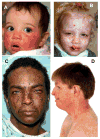Cancer and neurologic degeneration in xeroderma pigmentosum: long term follow-up characterises the role of DNA repair
- PMID: 21097776
- PMCID: PMC3235003
- DOI: 10.1136/jmg.2010.083022
Cancer and neurologic degeneration in xeroderma pigmentosum: long term follow-up characterises the role of DNA repair
Abstract
Background: The frequency of cancer, neurologic degeneration and mortality in xeroderma pigmentosum (XP) patients with defective DNA repair was determined in a four decade natural history study.
Methods: All 106 XP patients admitted to the National Institutes of Health from 1971 to 2009 were evaluated from clinical records and follow-up.
Results: In the 65 per cent (n=69) of patients with skin cancer, non-melanoma skin cancer (NMSC) was increased 10,000-fold and melanoma was increased 2000-fold in patients under age 20. The 9 year median age at diagnosis of first non-melanoma skin cancer (NMSC) (n=64) was significantly younger than the 22 year median age at diagnosis of first melanoma (n=38)-a relative age reversal from the general population suggesting different mechanisms of carcinogenesis between NMSC and melanoma. XP patients with pronounced burning on minimal sun exposure (n=65) were less likely to develop skin cancer than those who did not. This may be related to the extreme sun protection they receive from an earlier age, decreasing their total ultraviolet exposure. Progressive neurologic degeneration was present in 24% (n=25) with 16/25 in complementation group XP-D. The most common causes of death were skin cancer (34%, n=10), neurologic degeneration (31%, n=9), and internal cancer (17%, n=5). The median age at death (29 years) in XP patients with neurodegeneration was significantly younger than those XP patients without neurodegeneration (37 years) (p=0.02).
Conclusion: This 39 year follow-up study of XP patients indicates a major role of DNA repair genes in the aetiology of skin cancer and neurologic degeneration.
Conflict of interest statement
Competing Interest: None declared.
Figures



References
-
- Kraemer KH, Lee MM, Scotto J. DNA repair protects against cutaneous and internal neoplasia: evidence from xeroderma pigmentosum. Carcinogenesis. 1984 Apr;5(4):511–4. - PubMed
-
- Kraemer KH, Lee MM, Scotto J. Xeroderma pigmentosum. Cutaneous, ocular, and neurologic abnormalities in 830 published cases. Arch Dermatol. 1987 Feb;123(2):241–50. - PubMed
-
- Kraemer KH, Lee MM, Andrews AD, Lambert WC. The role of sunlight and DNA repair in melanoma and nonmelanoma skin cancer. The xeroderma pigmentosum paradigm. Arch Dermatol. 1994 Aug;130(8):1018–21. - PubMed
-
- Robbins JH, Kraemer KH, Lutzner MA, Festoff BW, Coon HG. Xeroderma pigmentosum. An inherited disease with sun sensitivity, multiple cutaneous neoplasms, and abnormal DNA repair. Ann Intern Med. 1974;80:221–48. - PubMed
Publication types
MeSH terms
Substances
Grants and funding
LinkOut - more resources
Full Text Sources
Medical
Research Materials
